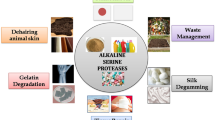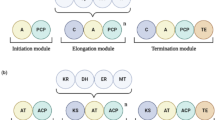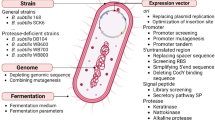Abstract
Bacillus amyloliquefaciens esterase (BAE) was applied to produce (R)-1-(3′,4′-methylenedioxyphenyl)ethanol, a chiral drug intermediate. In this study, we improved the enantioselectivity of BAE by protein engineering instead of process engineering as used in our previous work. Saturation mutagenesis was carried out on eight positions of BAE based on structure modeling and substrate docking. A double substituted variant V10 (K358D/A396C) showed an excellent enantioselectivity without decreasing the activity. The functions of these two mutations (K358D and A396C) were investigated, revealing a synergic effect on the BAE enantioselectivity. Using the variant V10, enantiopure (R)-1-(3′,4′-methylenedioxyphenyl)ethanol could be readily prepared in >97 % ee, affording a high space-time yield (123 g L−1 day−1) and a high ratio of substrate/catalyst (40 g g−1) in 1-L reaction.




Similar content being viewed by others
References
Barbayianni E, Kokotos CG, Bartsch S, Drakou C, Bornscheuer UT, Kokotos G (2009) Bacillus subtilis esterase (BS2) and its double mutant have different selectivity in the removal of carboxyl protecting groups. Adv Synth Catal 351(14–15):2325–2332
Bassegoda A, Nguyen GS, Schmidt M, Kourist R, Diaz P, Bornscheuer UT (2010) Rational protein design of Paenibacillus barcinonensis esterase EstA for kinetic resolution of tertiary alcohols. ChemCatChem 2(8):962–967
Bordes F, Cambon E, Dossat-Letisse V, Andre I, Croux C, Nicaud JM, Marty A (2009) Improvement of Yarrowia lipolytica lipase enantioselectivity by using mutagenesis targeted to the substrate binding site. ChemBioChem 10(10):1705–1713
Carballeira JD, Krumlinde P, Bocola M, Vogel A, Reetz MT, Backvall JE (2007) Directed evolution and axial chirality: optimization of the enantioselectivity of Pseudomonas aeruginosa lipase towards the kinetic resolution of a racemic allene. Chem Commun 19:1913–1915
Ema T, Fujii T, Ozaki M, Korenaga T, Sakai T (2005) Rational control of enantioselectivity of lipase by site-directed mutagenesis based on the mechanism. Chem Commun 37:4650–4651
Ema T, Kamata S, Takeda M, Nakano Y, Sakai T (2010) Rational creation of mutant enzyme showing remarkable enhancement of catalytic activity and enantioselectivity toward poor substrates. Chem Commun 46(30):5440–5442
Guieysse D, Salagnad C, Monsan P, Remaud-Simeon M, Tran V (2003) Towards a novel explanation of Pseudomonas cepacia lipase enantioselectivity via molecular modelling of the enantiomer trajectory into the active site. Tetrahedron Asymmetry 14(13):1807–1817
Hashiguchi S, Fujii A, Haack KJ, Matsumura K, Ikariya T, Noyori R (1997) Kinetic resolution of racemic secondary alcohols by RuII-catalyzed hydrogen transfer. Angew Chem Int Ed 36(3):288–290
Heinze B, Kourist R, Fransson L, Hult K, Bornscheuer UT (2007) Highly enantioselective kinetic resolution of two tertiary alcohols using mutants of an esterase from Bacillus subtilis. Protein Eng Des Sel 20(3):125–131
Henke E, Bornscheuer UT, Schmid RD, Pleiss J (2003) A molecular mechanism of enantiorecognition of tertiary alcohols by carboxylesterases. ChemBioChem 4(6):485–493
Janes LE, Lowendahl AC, Kazlauskas RJ (1998) Quantitative screening of hydrolase libraries using pH indicators: identifying active and enantioselective hydrolases. Chem Eur J 4(11):2324–2331
Kotik M, Archelas A, Famerova V, Oubrechtova P, Kren V (2011) Laboratory evolution of an epoxide hydrolase—towards an enantioconvergent biocatalyst. J Biotechnol 156(1):1–10
Koul S, Koul JL, Singh B, Kapoor M, Parshad R, Manhas KS, Taneja SC, Qazi GN (2005) Trichosporon beigelli esterase (TBE): a versatile esterase for the resolution of economically important racemates. Tetrahedron Asymmetry 16(15):2575–2591
Kourist R, Bartsch S, Bornscheuer UT (2007) Highly enantioselective synthesis of arylaliphatic tertiary alcohols using mutants of an esterase from Bacillus subtilis. Adv Synth Catal 349(8–9):1393–1398
Liu J, Tang XL, Yu HW (2010) Prediction of the enantioselectivity of lipases and esterases by molecular docking method with modified force field parameters. Biotechnol Bioeng 105(4):687–696
Liu JY, Zheng GW, Li CX, Yu HL, Pan J, Xu JH (2013) Multi-substrate fingerprinting of esterolytic enzymes with a group of acetylated alcohols and statistic analysis of substrate spectrum. J Mol Catal B Enzym 89:41–47
Liu JY, Zheng GW, Imanaka T, Xu JH (2014) Stepwise and combinatorial optimization of enantioselectivity for asymmetric hydrolysis of 1-(3′,4′-methylenedioxyphenyl)ethyl acetate using a cold-adapted Bacillus amyloliquefaciens esterase. Biotechnol Bioprocess Eng 19(3):442–448
Ma JB, Wu L, Guo F, Gu JL, Tang XL, Jiang L, Liu J, Zhou JH, Yu HW (2013) Enhanced enantioselectivity of a carboxyl esterase from Rhodobacter sphaeroides by directed evolution. Appl Microbiol Biotechnol 97(11):4897–4906
Ni Z, Lin XF (2013) Insight into substituent effects in Cal-B catalyzed transesterification by combining experimental and theoretical approaches. J Mol Model 19(1):349–358
Ollis D, White S (1990) Protein crystallization. Methods Enzymol 182:646–659
Park S, Morley KL, Horsman GP, Holmquist M, Hult K, Kazlauskas RJ (2005) Focusing mutations into the P. fluorescens esterase binding site increases enantioselectivity more effectively than distant mutations. Chem Biol 12(1):45–54
Qin B, Liang P, Jia X, Zhang X, Mu M, Wang XY, Ma GZ, Jin DN, You S (2013) Directed evolution of Candida antarctica lipase B for kinetic resolution of profen esters. Catal Commun 38:1–5
Reetz MT, Carballeira JD (2007) Iterative saturation mutagenesis (ISM) for rapid directed evolution of functional enzymes. Nat Protoc 2(4):891–903
Reetz MT, Zonta A, Schimossek K, Liebeton K, Jaeger KE (1997) Creation of enantioselective biocatalysts for organic chemistry by in vitro evolution. Angew Chem Int Ed 36(24):2830–2832
Reetz MT, Wang LW, Bocola M (2006) Directed evolution of enantioselective enzymes: iterative cycles of CASTing for probing protein-sequence space. Angew Chem Int Ed 45(8):1236–1241
Schliessmann A, Hidalgo A, Berenguer J, Bornscheuer UT (2009) Increased enantioselectivity by engineering bottleneck mutants in an esterase from Pseudomonas fluorescens. ChemBioChem 10(18):2920–2923
Schulz T, Pleiss J, Schmid RD (2000) Stereoselectivity of Pseudomonas cepacia lipase toward secondary alcohols: a quantitative model. Protein Sci 9(6):1053–1062
Spiller B, Gershenson A, Arnold FH, Stevens RC (1999) A structural view of evolutionary divergence. Proc Natl Acad Sci U S A 96(22):12305–12310
Wang MC, Zhang QJ, Zhao WX, Wang XD, Ding X, Jing TT, Song MP (2008) Evaluation of enantiopure N-(ferrocenylmethyl) azetidin-2-yl (diphenyl) methanol for catalytic asymmetric addition of organozinc reagents to aldehydes. J Org Chem 73(1):168–176
Wang MC, Zhang QJ, Li GW, Liu ZK (2009) Highly enantioselective addition of dimethylzinc to arylaldehydes catalyzed by (2S)-1-ferrocenyl-methylaziridin-2-yl (diphenyl) methanol. Tetrahedron Asymmetry 20(3):288–292
Wettergren J, Bøgevig A, Portier M, Adolfsson H (2006) Ruthenium-catalyzed enantioselective reduction of electron-rich aryl alkyl ketones. Adv Synth Catal 348(10–11):1277–1282
Wiggers M, Holt J, Kourist R, Bartsch S, Arends I, Minnaard AJ, Bornscheuer UT, Hanefeld U (2009) Probing the enantioselectivity of Bacillus subtilis esterase BS2 for tert. alcohols. J Mol Catal B Enzym 60(1–2):82–86
Zhang B, Wang H, Lin GQ, Xu MH (2011) Ruthenium(II)-catalyzed asymmetric transfer hydrogenation using unsymmetrical vicinal diamine-based ligands: dramatic substituent effect on catalyst efficiency. Eur J Org Chem 22:4205–4211
Zhao LL, Xu JH, Zhao J, Pan J, Wang ZL (2008) Biochemical properties and potential applications of an organic solvent-tolerant lipase isolated from Serratia marcescens ECU1010. Process Biochem 43(6):626–633
Zheng GW, Pan J, Yu HL, Ngo-Thi MT, Li CX, Xu JH (2010) An efficient bioprocess for enzymatic production of L-menthol with high ratio of substrate to catalyst using whole cells of recombinant E. coli. J Biotechnol 150(1):108–114
Acknowledgments
This work was financially supported by National Natural Science Foundation of China (Nos. 31200050 & 21276082), Ministry of Science and Technology, People’s Republic of China (Nos. 2011AA02A210 & 2011CB710800), and the Fundamental Research Funds for the Central Universities, Ministry of Education, People’s Republic China.
Author information
Authors and Affiliations
Corresponding author
Electronic supplementary material
Below is the link to the electronic supplementary material.
ESM 1
(PDF 88.1 kb)
Rights and permissions
About this article
Cite this article
Liu, JY., Bian, HP., Tang, Y. et al. Double substituted variant of Bacillus amyloliquefaciens esterase with enhanced enantioselectivity and high activity towards 1-(3′,4′-methylenedioxyphenyl)ethyl acetate. Appl Microbiol Biotechnol 99, 1701–1708 (2015). https://doi.org/10.1007/s00253-014-5992-0
Received:
Revised:
Accepted:
Published:
Issue Date:
DOI: https://doi.org/10.1007/s00253-014-5992-0




